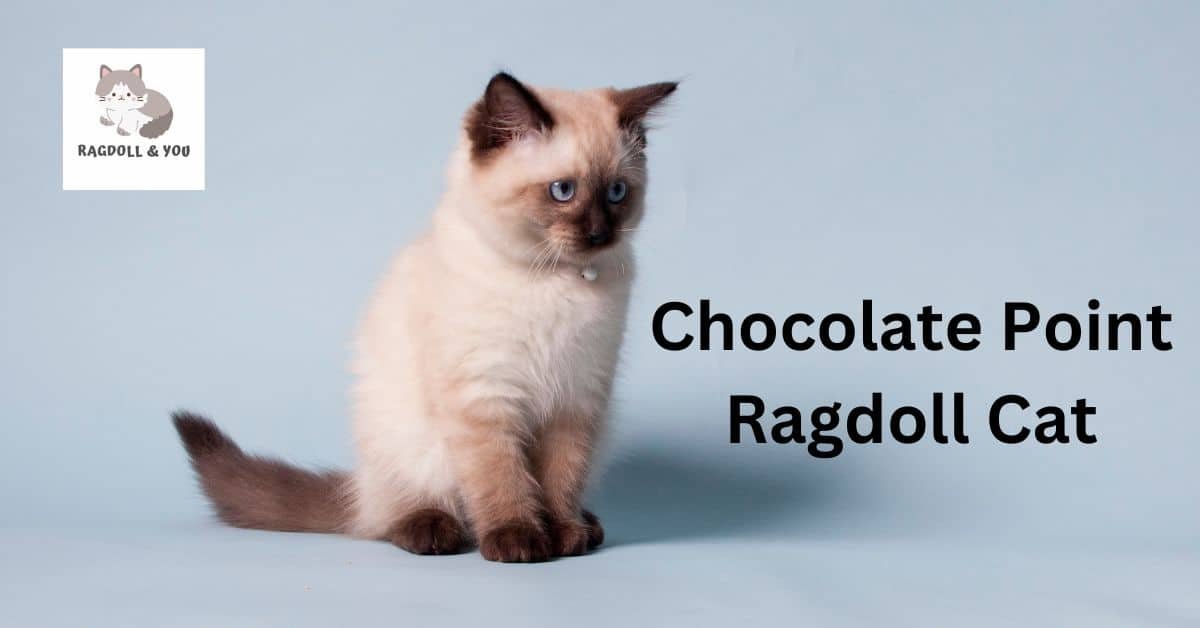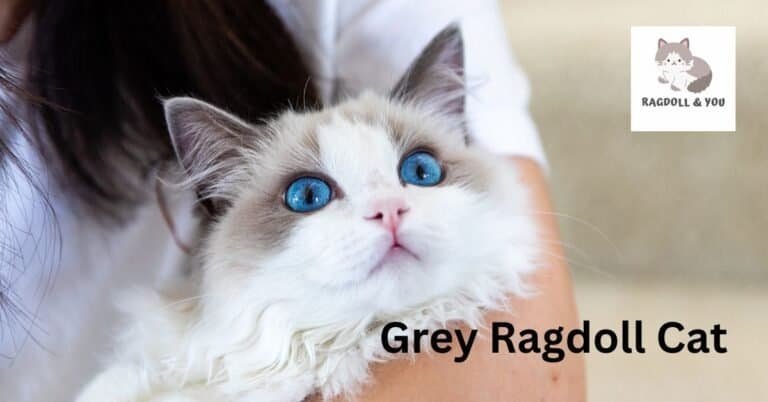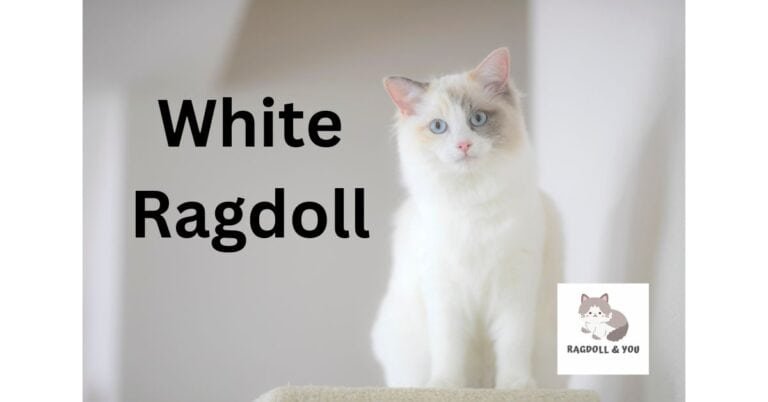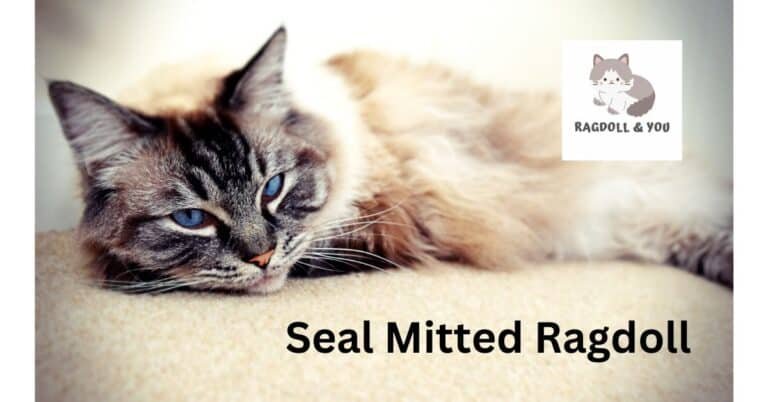Complete Guide On Chocolate Point Ragdoll Cat Color And Pattern
The chocolate point coat pattern is one of the most distinctive features of Ragdoll cats. Chocolate points have chocolate brown fur on the face, ears, legs, tail, and testicles, which contrasts elegantly with the lighter cream or ivory body color.
This medium brown “point” coloration is caused due to the dark brown seal point gene in ragdoll. Chocolate point is one of the original point color patterns established for the Ragdoll breed in the 1960s.
Ragdoll Kittens are born completely pale with almost no point coloration. Yes, the kittens are born completely white. The chocolate brown starts to appear on the points at around 1-2 weeks and progressively darkens until maturity.
Though rarer than other colors like blue or seal point, the chocolate point’s striking looks make it a top choice for many Ragdoll lovers. This guide will explore everything you need to know about this classic Ragdoll color and pattern.

What Does “Chocolate Point” Mean In Ragdolls?
A “chocolate point” Ragdoll has medium brown coloring on the face, ears, legs, tail, and testicles/scrotum (known as the “points”), which contrasts with a lighter cream, ivory or pale fawn body.
The chocolate brown point color of the cat is a dilution of the darker seal brown points found in seal point Ragdolls. “Point” refers to this contrast between the darker points and lighter body.
Chocolate point is one of the original classic Ragdoll patterns, along with seal point and blue point, and remains very popular today. In cat registries and breeding standards, chocolate point Ragdolls are classified as “Ragdoll Colorpoint Pattern, Chocolate Mitted/Bicolor/Van.
The exact shade of the chocolate points can range from lighter milk chocolate to deep dark chocolate brown. Kittens may have lighter points that darken as they mature. Proper chocolate point Ragdolls should exhibit a clear difference between the point and body colors, with minimal tabby stripes in the points.
Chocolate Ragdoll Cat Breed Overview
Physical Appearance
The chocolate point Ragdoll has medium brown fur on the face, ears, legs, tail, and testicles that contrasts elegantly with the paler cream or ivory body. This brown “point” color results from a dilution of the dark seal brown gene.
The eye color is a vivid blue. Point colors may appear lighter when the cat is cool and darker when warm. Chocolate points have a distinct contrast between the richer point and lighter body colors. The coat is semi-long and silky soft.
Genetics
The chocolate gene is likely recessive in Ragdolls, making this color rarer. Two chocolate parents or carriers are needed to produce chocolate kittens.
Unlike some cats, Ragdolls only carry the gene for solid chocolate or seal with no orange. Dilution of seal results in chocolate, while further dilution leads to lilac or fawn points. But chocolate remains one of the original Ragdoll point patterns.
Trainability
The sweet, laidback temperament of the Ragdoll breed lends itself well to training. Like all Ragdolls, chocolate points tend to be extremely affectionate, relaxed, gentle and eager to please. Positive reinforcement training that rewards good behavior with treats and praise is highly effective.
Chocolate points enjoy learning tricks and games that provide mental stimulation and quality time with their adored owners. Their intelligence and bonds with humans make Ragdolls of all colors highly trainable.
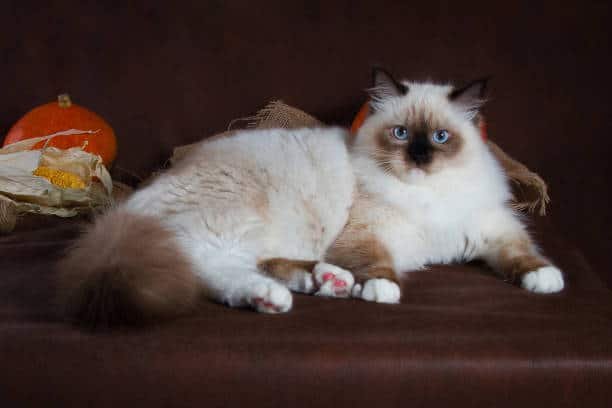
Cat Personality
The chocolate point Ragdoll has the same famously sweet, gentle personality the breed is known for. Ragdolls tend to be extremely affectionate, relaxed, docile, and people-oriented cats that form strong bonds with their families. They love being held and pampered with petting.
Chocolate points often follow their owners from room to room like a puppy. They typically get along well with other pets and children. While playful and energetic as kittens, chocolate points become mellow, calm, peaceful companions as they mature.
But they maintain a kitten-like curiosity and playfulness throughout adulthood. Their loving personality makes them ideal family pets.
Grooming of Chocolate Point Ragdoll Cats
To keep a chocolate point Ragdoll’s fur looking its best, frequent brushing is a must. Their fur doesn’t have much of an undercoat, so it tangles easily.
Gently brushing with a steel comb or slicker brush removes tangles and distributes oils from the skin. Pay extra attention to areas prone to tangles like the legs, tail, and behind the ears.
Bathing a chocolate point Ragdoll every 2-3 months enhances the glow of the coat. Use a gentle shampoo made for cats.
Make sure to brush out all tangles before bathing thoroughly. This will ensure the shampoo penetrates down to the skin.
Other grooming tips include wiping eye corners daily to minimize stains, trimming nails every few weeks, and checking inside the ears.
The tufts and paws in the Chocolate Point areas may need extra grooming attention. Use a conditioner or serum on the points if they seem dry.
It’s also important to limit sun exposure, as the chocolate fur can fade or bleach out in the sun. With proper weekly brushing and grooming of areas like the eyes, ears and paws, a chocolate point Ragdoll’s coat will stay stunning. The grooming will accentuate the rich chocolate points against the paler cream body.
Diet for Chocolate Point Ragdolls
As a large breed reaching 15-20 pounds, they require a high-quality diet with adequate protein and fat to support their muscle growth and energy needs. But calories should be monitored to prevent obesity.
Like all cats, Ragdolls require balanced levels of amino acids like taurine, arginine, methionine, and lysine. Taurine deficiency can cause serious heart and eye problems. Both kitten and adult Ragdoll foods should contain ample taurine and be meat-based.
Wet and dry food can be fed, but a partial or all wet food diet is ideal to increase moisture intake. Canned food also provides more protein and mimics their natural diet. Dry kibble should be high in meat proteins.
Antioxidants from fruits, veggies, and omega fatty acids help maintain the chocolate point coat color and skin health. Natural preservatives are preferable over artificial ones. Multiple small meals per day help prevent gorging and obesity.
Avoid fish-based foods which may lead to hyperthyroidism. Also avoid grains like corn, wheat, and soy which are common allergens for cats. Ensure fresh, filtered water is always available.
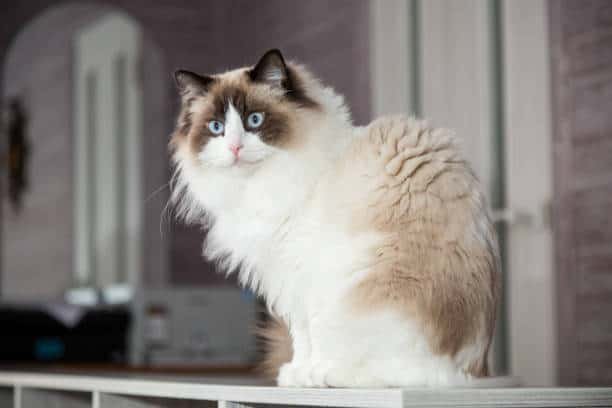
Colors and Patterns of Chocolate Point Ragdoll Cat & Kitten
Let’s look at the various type of ragdoll cats with chocolate points
Chocolate Point Bicolor Ragdoll Cat
The chocolate bicolor Ragdoll has white markings on the face, chest, underside, paws, and sometimes on the back. This contrasts with the chocolate brown points on the ears, tail, mask, and legs. The inverted ‘V’ facial mask and mitted white paws are striking. Blue or aqua eyes.
Chocolate Mink Ragdoll Cat
The chocolate mink Ragdoll has a warm milk chocolate coat instead of defined points. The body is a lighter chocolate shade while the extremities are a rich dark chocolate. No contrast points in this variety. Eyes are blue.
Chocolate Lynx Ragdoll Kitten
Chocolate lynx point Ragdolls have tabby stripes in their chocolate brown points. The stripes are darker chocolate, while the background of the points is lighter milk chocolate. The body is cream-colored with little striping. Kittens are born very pale.
Chocolate Mitted Ragdoll Cat
This cat has milk chocolate points and white mittens on its paws. Also, often a white chin, chest, and belly. The body is an ivory or pale cream. Eye color is blue or aqua. Kittens have faint points at birth.
Solid Chocolate Color Ragdoll Cat
The solid chocolate Ragdoll has a warm milk chocolate coat over the entire body, including points. No contrasting areas of color. Blue eyed. Difficult to find as breeding usually results in pointed kittens.
Chocolate Seal Ragdoll Cat
Very similar to the chocolate point with the same color contrast. Seal refers to a very dark, almost blackish brown point color as opposed to warm milk chocolate. Eyes are deep blue.
Chocolate Tortie Point Ragdoll Kitten
A mix of chocolate and shades of red in the points of these Ragdolls. The body is cream. Mottling varies in amount. Kittens are born very pale with points emerging around 2 weeks old.
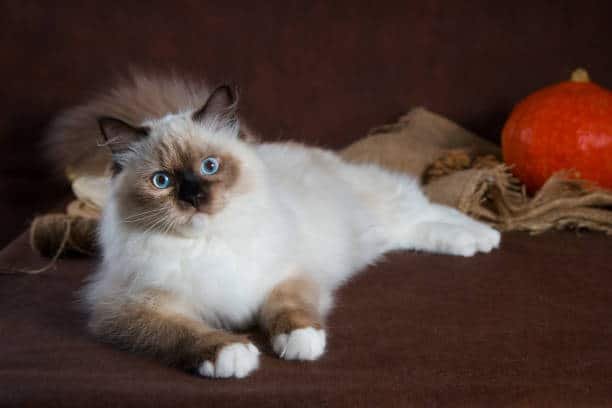
Chocolate vs Seal Point Ragdoll
The Chocolate Point Ragdoll and Seal Point Ragdoll are two variations of the Ragdoll breed. While they both belong to the same breed, there are several differences.
| Chocolate Point Ragdoll | Seal Point Ragdoll | |
| Difference in Color Points | The points on a chocolate point Ragdoll is a lighter brown. | The points on a seal point Ragdoll are typically a dark, deep brown. |
| Intensity of Color | The Chocolate point variety has a more uniform color, with less contrast between their body color and points. | Seal point Ragdolls have a higher contrast between their body color and points, making their points stand out more. |
| Facial Features | Have more dark brown fur on their faces, extending from their eyes to their muzzles and mouths. | Seal point Ragdolls have less dark fur on their faces than chocolate points. |
| Eyes | The eyes of a chocolate point Ragdoll are typically blue. | The eyes of a seal point Ragdoll are also blue, but can sometimes be a lighter shade. |
| Body Color | The chocolate point Ragdoll generally has a pale cream-colored body. | The body of a seal point Ragdoll is typically a cream color. But it may be slightly darker than a chocolate point. |

Chocolate-Pointed Ragdoll Health Issues
Chocolate-pointed ragdolls are prone to health conditions like gum disease, cardiomyopathy, gastrointestinal issues, and respiratory tract issues.
Gum Disease
Gum disease is a common health issue affecting Chocolate-Pointed Ragdoll cats. It occurs when the deep structures supporting a tooth are affected, leading to tooth loss.
Ragdolls, including chocolate point ones, are prone to dental disease and need proper oral care. Gum disease can cause discomfort and impact their overall health traits.
Regular dental check-ups and frequent brushing of their teeth prevent gum disease in these cats.
Cardiomyopathy: Heart Diseases
Ragdoll cats are prone to a heart disease called hypertrophic cardiomyopathy (HCM). This condition causes the heart muscle wall to thicken, which can lead to heart failure.
Unfortunately, the cause of HCM in Ragdolls is still unknown. While Ragdolls are generally healthy, cat owners must be aware of this potential health issue and take precautions.
Regular check-ups with a veterinarian and a healthy weight through proper diet and exercise reduce the risk of HCM. A few minutes of activity daily stimulates their brain and body.
Gastrointestinal: Gastro Problems
Ragdoll cats can have problems with their stomach and digestive system. One common issue is called Inflammatory Bowel Disease (IBD), a chronic condition.
It causes difficulty in pooping, blood in the stool, throwing up, losing weight, feeling tired, and having diarrhea or constipation.
Ragdolls may experience other gastrointestinal problems, including indigestion, heartburn, acid reflux, irritable bowel syndrome (IBS), constipation, bloating, and diarrhea.
Pay attention to your Ragdoll cat’s digestive health traits and provide them with a balanced diet.
Respiratory Tract Issues
Chocolate Pointed Ragdolls are prone to respiratory issues like cat flu and feline asthma. Their flat faces and short noses make them more susceptible to breathing difficulties.
Upper respiratory infections are relatively common in Ragdolls, which can cause sneezing, coughing, and difficulty breathing.
Ragdolls can develop asthma due to their facial structure, leading to wheezing and shortness of breath.

Chocolate Ragdoll Kitten Life Cycle
Birth to 2 Weeks
Kittens are born with blue eyes and very pale chocolate point coloring. They nurse constantly, cannot regulate their body temperature, and depend fully on their mother.
2-4 Weeks
The kittens’ eyes start changing to blue-green. They begin wobbling around the nest and playing with litter mates. They start the weaning process as their mother introduces solid food.
1-2 Months
Now the kittens explore outside the nest. Their point color starts to appear but is still diluted. They play energetically and may try solid foods. They get their first vaccinations around 8 weeks old.
3-4 Months
The chocolate point markings develop more depth and contrast. The kittens are very active and curious. Socialization is critical at this stage. They can be spayed/neutered at 5 months old.
5-7 Months
The kittens have good control over bodily functions now. Their points take on the adult chocolate hue and their eye color settles into a bright blue. They form close bonds with human companions through play and cuddling.
8 Months to 1 Year
The kittens transition into adulthood. Females reach sexual maturity. Their coat is sleek and lustrous, and points are quite dark. Behavior calms down but playfulness still emerges.
1-2 Years
The young adults fill out to 10-15 pounds. Their coat and eye colors are fully developed. Their personality blossoms into the sweet, gentle temperament Ragdolls are known for.
Pros and Cons: Chocolate Point Ragdoll
The Chocolate Point Ragdoll is a popular breed with a friendly and affectionate nature. Here’s a table to give you a better understanding:
| Pros | Cons |
| Known for its peaceful, docile, and even-tempered nature. | Prone to certain health issues like gum disease, heart disease, and gastrointestinal problems. |
| Rarely exhibits aggression, like hissing or swiping, making it an ideal choice for families with kids. | Requires regular grooming due to its large size and fluffy coat. |
| Its warm milk chocolate shades for its points make it a visually appealing breed. | It may require a specific diet to maintain its health and coat quality. |
| Friendly and affectionate like other color varieties of Ragdoll, making it a beloved companion. | This breed is known for changing cat colors due to body temperature and age. It may not be desirable for all feline owners. |
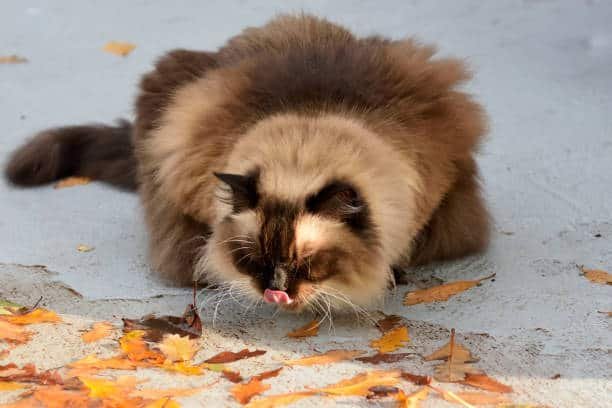
FAQ
Are chocolate point Ragdolls rare?
Yes, chocolate point Ragdolls are considered one of the more rare and uncommon coat colors in the breed compared to other point patterns like seal and blue.
What are the traditional ragdoll breed colors?
The traditional Ragdoll colors are seal, blue, chocolate, and lilac points, as well as solid, tortie, and bicolor variants of these four original point colors.
Where can I find chocolate ragdoll breeder?
Look for reputable Ragdoll breeders through breed clubs and be prepared to wait, as chocolate Ragdolls may be harder to find than other color varieties. Vet potential breeders carefully for health testing and expertise with chocolate lines specifically.
What is a chocolate point Ragdoll?
A chocolate point Ragdoll has medium brown fur on the face, ears, legs, tail and testicles (the points), which contrasts with a lighter cream or pale fawn colored body. It is one of the classic color patterns for the Ragdoll breed.
How much does a chocolate point Ragdoll cat cost?
On average, a chocolate point Ragdoll kitten from a reputable breeder costs $1000-$2000. Show quality cats with champion bloodlines can cost $2500 or more. Price varies based on breeder reputation, location, bloodline, and whether breeding/show rights are included.
What is the most desired Ragdoll color?
The seal point pattern, with very dark brown almost black points, is generally considered the most popular and desirable Ragdoll color. But many people love the striking contrast of chocolate point Ragdolls too.
What’s the difference between a seal point and a chocolate point Ragdoll?
Seal point Ragdolls have very dark brown, almost black points, while chocolate point Ragdolls have lighter, medium brown points. The chocolate point color is a dilution of the dark seal point gene.
Are Chocolate Point Ragdolls Friendly?
Yes! Like all Ragdolls, chocolate point cats tend to have very sweet, calm, friendly personalities. Their affectionate nature is a defining breed trait, regardless of coat color.
Are Chocolate Ragdoll Cats hypoallergenic?
No. No cat is truly hypoallergenic as people are allergic to cat proteins in dander and saliva, not fur. But Ragdolls do produce less dander and may cause less reaction than other cats. There is no evidence chocolate points are any better for allergies than other Ragdolls.
Are Chocolate Ragdolls born brown?
No, chocolate point kittens are born white. Their points start to develop a light brownish grey color at a few days old and progressively darken as they mature. Full chocolate point color is not attained until over a year old.
Are overweight chocolate Ragdolls darker in color than slim ones?
Yes, excess weight can make the chocolate point coloration appear darker or faded. The contrast between the points and body may be less defined in an overweight cat. Slim Ragdolls showcase the silky coat texture and vivid point color best.
Can Chocolate Ragdolls change color?
To some degree, yes. The coat may lighten or fade with age, sun exposure, nutrition, and weight changes. But a true chocolate point will still retain the medium brown points with lighter body as an adult. The coat color can darken with maturity.
Do Chocolate Point Ragdolls shed a lot?
Ragdolls have a single coat with little undercoat, so they don’t “blow” seasonal coats. But they do shed a moderate amount year-round like any cat. Regular brushing helps reduce loose hair. Their long fur can require maintenance to prevent tangles and mats.
Do all Chocolate Ragdolls have blue eyes?
Yes, chocolate point Ragdoll kittens are born with blue eyes that stay blue throughout adulthood. Their bright blue eyes and chocolate fur create a stunning facial contrast. Other Ragdoll patterns may have blue, green, or odd-eyed. But chocolate points will always have blue eyes.
How do chocolate Ragdolls change color when their body temperature is low?
The chocolate fur will appear lighter and less intense when the cat is cold. The contrast between the body and points will be less defined. This is due to temperature-sensitive pigments in the hair. When warm, the chocolate color becomes richer.

